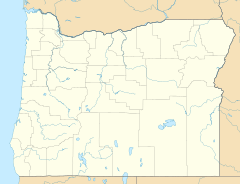Blalock, Oregon facts for kids
Quick facts for kids
Blalock, Oregon
|
|
|---|---|
|
Former community
|
|
| Country | United States |
| State | Oregon |
| County | Gilliam |
| Time zone | UTC-8 (Pacific) |
| • Summer (DST) | UTC-7 (Pacific) |
| GNIS feature ID | 1164926 |
Blalock was once a small community in Oregon, located right by the big Columbia River. It was in a beautiful area called the Columbia River Gorge in Gilliam County, Oregon. Before it was called Blalock, this special place was home to a Native American settlement known as Táwash.
Blalock was about 7 miles (11 km) west of a town called Arlington. You could find it along major roads like Interstate 84 and U.S. Route 30. Even though the community is gone, you can still find a train station named Blalock on the Union Pacific Railroad line today. This train line was originally called the Oregon Railway and Navigation Company.
History of Blalock
The community of Blalock was named after Dr. Nelson G. Blalock. He was a veteran from the American Civil War who moved to the Walla Walla area. Dr. Blalock started a very large farm, thousands of acres big, on the flat land next to the Columbia River.
Early Days and Growth
People first started settling in the Blalock area in 1879. A post office was officially opened there in 1881. The town itself was planned out in 1881 by the Blalock Wheat Growing Company.
The first two buildings in Blalock were a railroad station and a warehouse. These were built by A. J. McLellan, who worked for the Oregon Railway and Navigation Company.
By 1884, Blalock was an important place for shipping wheat. There were also daily stagecoaches that traveled to Heppner. The town had about 50 people living there at that time.
What Blalock Was Like
Records from the Polk Directory show what life was like in Blalock. The town had two clergymen, who were religious leaders. There was also a saloon, a wagonmaker, and a ferryman who helped people cross the river. Blalock also had a hotel, a general store where you could buy many things, and a lawyer. You could also find a dealer who sold lumber, coal, and animal feed.
In 1904, the town handled a huge amount of wheat, about 750,000 bushels! By 1905, Blalock had grown to include two large grain warehouses, a hotel, and a general store. There was also a livery and stage stable, which was a place for horses and stagecoaches. The town even had a real estate office and a factory that made agricultural implements, which are tools for farming.
The End of Blalock
In 1940, the population of Blalock was 19 people. The post office in Blalock closed down in 1959.
The community of Blalock eventually disappeared. In 1968, the area was flooded by the waters from the John Day Dam. This dam created a large reservoir, and the old town of Blalock was covered by the water.



